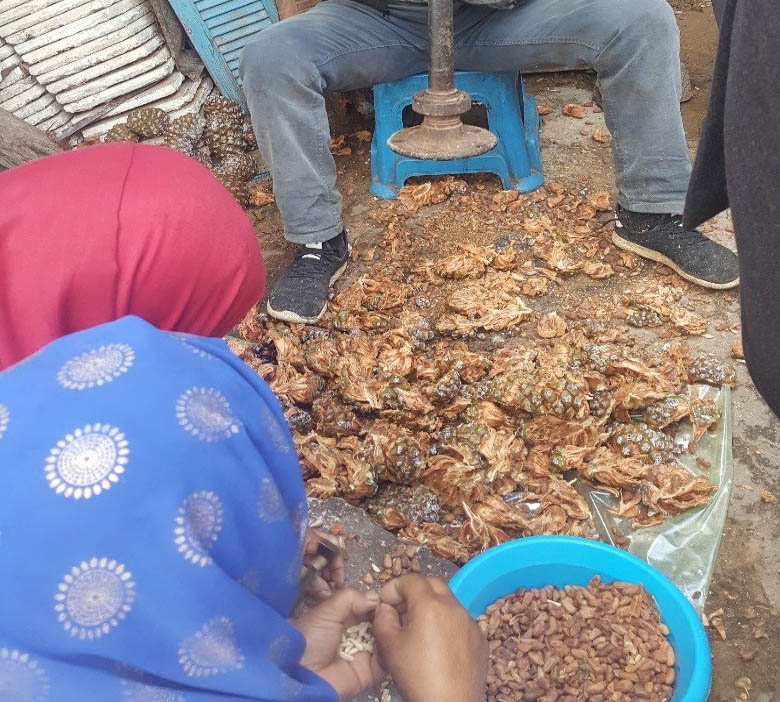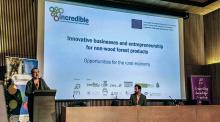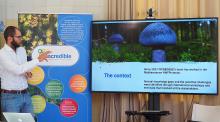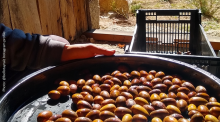Pine nuts production in Tunisia: A review of stakes practices and socio-economic constraints

Last November 13th, more than 30 persons attended the Science to Practice event held in the north west of Tunisia (Nefza) to explore Pine nuts extraction practices and the economic importance of this product to local population livelihood.
The stone pine has been introduced in Tunisia a long time ago; the first plantations were carried out in the region of Dar Chichou (Cap Bon) and Rimel (Bizerte) at the end of the 19th century to fix the coastal dunes. The total area of stone pine in Tunisia covers around 20000 Hectares. The Stone Pine forests in Nefza delegation covers more than 5000 Hectares. Over the last 15 years, a radical change in the practice of pinion pinecone harvesting has been observed. The Administration organized auctions to sell the right to exploit these cones, but for more than 10 years, there have been fewer and fewer buyers because of the illegal harvests.
Forests are managed and administrated by the state forest agency, which are perceived as being accessible to all. The majority of people interviewed during the science to practice event recognize that it is not advisable to carry out premature harvests, but say that if they do not harvest the cones quickly, "Free riders" will do so before them. They could be pickers from the same area or from other regions. Indeed, the most suitable period to collect pinecones is during the autumn between October and November. Collecting cones during this period is very important to have the highest levels of quality and production yield. However, in Tunisia this season is held earlier than expected (start in August), causing huge losses for foresters, in terms of future production, and for the forest population, in terms of pine’s quality.
Early harvest threatens local ecosystems that produce stone pine plantations as well as affects the potential effectiveness of the natural regeneration that becomes more and more impossible. Foresters asserted that pinecones do not even touch the ground because they are harvested before reaching maturity. In addition, local population tends to harvest pinecones too early to fund their children’s education, as harvesting and extracting pine nuts ensure a significant income support, which could reach 6000 Dinars per family per year.
Various actors are involved in the pine nuts value chain. They are mainly informal workers given the lack of legal access to raw materials. The pine stands of pine trees are state-owned plantations managed by the forest service from the production stage at the nursery to forestry operations, pruning and thinning. Cone collectors and processors (extraction of seeds) live around the pine forest areas, which are mainly located in the north of the country. These actors are operating individually or in groups (agricultural development groups, GDA). Traders and collectors have a key role in controlling the marketing system in production areas. They have a strong relationship with large-scale traders and wholesalers who ensure the transport of harvested pine nuts to Tunis.
Actually, young people and adults living around forest areas insure the harvest activity. Workers engaged to climb trees are mainly composed of men and children. However, this activity is often carried out without necessary climbing and safety equipment. Some accidents have been reported in the Nefza region. After that, cones are transported to households to extract kernels through two steps; the extraction of seeds (after drying for a few days) then the pine nuts (over an extended period and according to demand). Women usually take care of the shelling of cones and seeds using traditional extraction methods. The extraction of pine nuts is a difficult task and labor intensive since it requires more effort to break the cone.
Another challenging problem to be addressed by DGF is adopting a robust management system of stone pine forests, which in turn would allow better legal access to forest resources by the local communities and different stakeholders involved in this activity. Furthermore, promoting appropriate technologies and equipment for more efficient extraction of pine can help to strengthen the resilience of socio-ecological systems and the economic status of local populations.
Finally, policymakers place great importance on developing inclusive and more integrated policy solutions that satisfy the needs of both foresters and forest populations. Moreover, there is still a need to transmit to local communities the importance of respecting the annual growth cycle of pine. Extension campaign, information and training courses would increase their awareness towards quality production as well as to preserve the future forest resources.















 ‘Innovation Networks of Cork, Resins and Edibles in the Mediterranean basin’ (INCREDIBLE) project receives funding from the European Commission’s Horizon 2020 programme under grant agreement Nº 774632
‘Innovation Networks of Cork, Resins and Edibles in the Mediterranean basin’ (INCREDIBLE) project receives funding from the European Commission’s Horizon 2020 programme under grant agreement Nº 774632
Comments (12015)
barkkei c2936d4fca https://sway.office.com/HFQSCF6uVqtuVuvo
https://sway.office.com/yrFLdFrJEJHdERBn
https://sway.office.com/DLMn1RMjlv2qkU5i
https://sway.office.com/QM1UztEuGYrAh3ZD
https://sway.office.com/aRmp8HEOS4A5PiqC
https://sway.office.com/zPMkweMFCjBVdQTP
https://sway.office.com/0laRS2fd8eSmOo86
https://sway.office.com/AH3DdcA1VCtYuxMb
https://sway.office.com/UgfOmPKrtSO0ew3p
https://sway.office.com/WfVUWbzGT6SU3KoW
http://www.fussballforum-mv.de/forum/index.php?page=UserGuestbook&userID=32808&pageNo=1
rosabal c2936d4fca https://sway.office.com/hcj2RpLTk14ZowEA
https://sway.office.com/Ini7alNDVBsi1lPT
https://sway.office.com/OJWjlgd6agSZEkIc
https://sway.office.com/8GaNaMGsuMRNVCjH
https://sway.office.com/hN5rnHzuslfrMM3i
https://sway.office.com/38Z6UE1X7r7IIk4j
https://sway.office.com/Xdwi5d2z3LaqoAup
https://sway.office.com/iSwV2xawPTPJvvoy
https://sway.office.com/9tDiFaBqJaJoRu1J
https://sway.office.com/DiNaE3W42XcesKCZ
http://kpsold.pedf.cuni.cz/index.php?a=115&addpost&page=1
best ringtones https://ringtonessbase.com
best ringtones https://ringtonessbase.com
best ringtones https://ringtonessbase.com
clarbir c2936d4fca https://sway.office.com/quSs2CfAfcxFCH8F
https://sway.office.com/jKVJ7H1rW3gCTVA4
https://sway.office.com/z7FPzjMeAioHhARZ
https://sway.office.com/PTLdLwcCZq8nQP55
https://sway.office.com/WPnuqRgYKds7YJ4H
https://sway.office.com/p4LMEb58VAnBqxUy
https://sway.office.com/3A8QnnVWENllACCy
https://sway.office.com/1mh3jD3uMNlFxZOG
https://sway.office.com/edD5GnL98HNWX0AD
https://sway.office.com/SaY4npPUljiD6aK4
http://www.hsyufuji.com/plus/guestbook.php
walcata c2936d4fca https://sway.office.com/BJa2hpfnVUIPUnp0
https://sway.office.com/aVdXeduELiBeCto0
https://sway.office.com/gaB7OL8zAT4qN6Np
https://sway.office.com/Dr9nHDh866BwAYxP
https://sway.office.com/sO4eJdMCXLVMTrnG
https://sway.office.com/aiqcVYGoOQUxqbu2
https://sway.office.com/CUiSBggeyICyvqkA
https://sway.office.com/B5UIBvcun6cwQkdj
https://sway.office.com/xBHOk30dT3Xhuvu2
https://sway.office.com/2ESUCaNa4ACBWstc
https://muruguay31h.ocnk.net/bbs
best ringtones https://ringtonessbase.com
best ringtones https://ringtonessbase.com
best ringtones https://ringtonessbase.com
margeval c2936d4fca https://sway.office.com/AxqrkWwVVZDrKTdu
https://sway.office.com/CYlWNblMpNmwELbc
https://sway.office.com/96OH3fYYfQiF4RtS
https://sway.office.com/kcDlRxLWTzyLmFo0
https://sway.office.com/IRRl5UlxZIVlRwK5
https://sway.office.com/KxOPebjgttWsuhHS
https://sway.office.com/d24Y90rBEqpW3eRM
https://sway.office.com/t6HUpjdyE8c7oJ6H
https://sway.office.com/ZEfRA9NnJbalcB0W
https://sway.office.com/2BNSw4dj1nDfebcq
http://snow-drop-tales.sakura.ne.jp/s/yybbs63/yybbs.cgi
harlquy c2936d4fca https://sway.office.com/eESsQs9sWFWSAyCg
https://sway.office.com/wxDCoN5tjQn6HAj7
https://sway.office.com/1Akrgw1yGTZW0tS7
https://sway.office.com/y8pFG0GdyVF6XWE2
https://sway.office.com/KYZAnrWpwVjRVXxX
https://sway.office.com/gASxxFOQCZDUdK1T
https://sway.office.com/945bGrBDHuAQOfmK
https://sway.office.com/HHa5OrhX8bDXD7q7
https://sway.office.com/EMxssUSv5bZiHAm5
https://sway.office.com/2GXMzOxC1yDRtz8N
http://www.crossover-ingelheim.de/erlangerhof/gaestebuch.php
best ringtones https://ringtonessbase.com
fentaly c2936d4fca https://sway.office.com/BMiCmgpMUGIiFYDd
https://sway.office.com/i7lFKUuikuyIanrm
https://sway.office.com/s161CTtYRkHqU8pi
https://sway.office.com/75qXVF9i7yOs8DDj
https://sway.office.com/xomtzU2aye6CYrLJ
https://sway.office.com/RQ2MGeXsfSnaewTA
https://sway.office.com/YcDp3redj7QwQP1w
https://sway.office.com/0leVS9VPmttqaXVX
https://sway.office.com/gBZNCjFHVEwCbIds
https://sway.office.com/UFacSNWLfnpqchyW
http://www.anjaschiffers.de/gaestebuch.php
best ringtones https://ringtonessbase.com
best ringtones https://ringtonessbase.com
peagus c2936d4fca https://sway.office.com/aHb87UPkeBLWtEpW
https://sway.office.com/wMBnmXaK3pwNzmG1
https://sway.office.com/ygGNH8BvmGIKijJc
https://sway.office.com/1Phtt4rSmHfMbqos
https://sway.office.com/pqdSgecCUW9FAaIS
https://sway.office.com/LhOH8RRxXbdZohgB
https://sway.office.com/BeODr1LxuPBvok9E
https://sway.office.com/iDm5JpOSkTbetXbu
https://sway.office.com/tBDoehfwJ1Lu2HjC
https://sway.office.com/nVIDlrmlqQJytokJ
http://wadavidson.co.za/component/k2/item/1/%3Cbr
scevlei c2936d4fca https://sway.office.com/IUS2GTj4ihOLERNx
https://sway.office.com/LqOqXV8STkVEe0AQ
https://sway.office.com/azqRFEvQ7MsgUH7c
https://sway.office.com/1jGfDAWdDId4UT7I
https://sway.office.com/WOkvfq6XvsNCYeg1
https://sway.office.com/aFP8qQZRZgDAIDQ0
https://sway.office.com/05XKpU0sMpgHRTBn
https://sway.office.com/6coBYGhBEjt1BzrU
https://sway.office.com/MBPwcOdeiMx86F1Y
https://sway.office.com/R4oNSzcSuH5wmIpl
http://club-black.do.ai/lab/JoyfulNote/joyful.cgi
latdarn c2936d4fca https://sway.office.com/o5SkrooAWkIGDRVK
https://sway.office.com/3rwmubJmQM2uwYj8
https://sway.office.com/6MuRKhkPCJIBnRB6
https://sway.office.com/0GcidgvRAp6qJMbg
https://sway.office.com/SqAWHFh7bKQdnCoL
https://sway.office.com/IMmcoBefUhD9Xqdg
https://sway.office.com/gtOt6ZgDBj8B28Ir
https://sway.office.com/N4JGhHhsCnFESbKu
https://sway.office.com/ELcVCBBgCYelPqcF
https://sway.office.com/2B9yPeVJ8XcYGPhe
https://glamorous-runners.jimdofree.com/g%C3%A4stebuch/
best ringtones https://ringtonessbase.com
best ringtones https://ringtonessbase.com
bercaed c2936d4fca https://sway.office.com/0LXepXFVwQDXMFLG
https://sway.office.com/YUAQHjgWYEtypYhg
https://sway.office.com/vgTHkIaeiHPPOnJi
https://sway.office.com/H5nOnIJY2XM7c11J
https://sway.office.com/7deiojRk4E878c6t
https://sway.office.com/pJeuQmOSDdeGX4Ou
https://sway.office.com/zy1TFA16LOA2KpN1
https://sway.office.com/3cum8xK3Ly9vsTaE
https://sway.office.com/JGoLzjv7zcCRHVnr
https://sway.office.com/XoczzEFEbQbIHjpP
http://talk.gamemc.eu/index.php?site=profile&id=23255&action=guestbook&page=1&type=ASC
nejrav c2936d4fca https://sway.office.com/pthr3OX8V6wVefpW
https://sway.office.com/BigP5rBkHgTUp5a4
https://sway.office.com/ZCzHgmZbbxJQWfQc
https://sway.office.com/aYsGJTRvkqmgC46m
https://sway.office.com/uqntSS1ImACiXlzG
https://sway.office.com/Iqq0jff71fiEuB3L
https://sway.office.com/OKh6rEtFjv8I36aR
https://sway.office.com/vBJ7YcF1kAUVBFq8
https://sway.office.com/vNiYI5q6kDd3NC7o
https://sway.office.com/ApQ7yg4W6j7WV3nu
https://svinkates.jimdofree.com/viesu-gr%C4%81mata/
best ringtones https://ringtonessbase.com
best ringtones https://ringtonessbase.com
nevypere c2936d4fca https://sway.office.com/G0cCm00trTl3hgqG
https://sway.office.com/jqyLEGrGZ6Nw9ngT
https://sway.office.com/3TzcvGu9LbByYw6w
https://sway.office.com/tyBtllCz6kR850K0
https://sway.office.com/yqbG0Xjkf5s0njy6
https://sway.office.com/61SI04jlbsCFggWz
https://sway.office.com/QC81PunQterx1wcb
https://sway.office.com/PUd7nm4lOql0t749
https://sway.office.com/N6nNXYaRYjcLA01X
https://sway.office.com/i21vcAFadFZeeLMi
http://school10.tgl.net.ru/component/kide/popup
best ringtones https://ringtonessbase.com
best ringtones https://ringtonessbase.com
waipall c2936d4fca https://sway.office.com/EnF90uabUsfhUStf
https://sway.office.com/WENsaGbjLvcfAtve
https://sway.office.com/6GBSHFPMxQVfMuhx
https://sway.office.com/HtxXOESMV9SBIM3p
https://sway.office.com/niZ9nBNMMQabckBq
https://sway.office.com/wFdgzqIl68hq6nxm
https://sway.office.com/oJf43f6N99BXdPOZ
https://sway.office.com/i8eoUghfYXyCVkqb
https://sway.office.com/3Ud8RlT8wwmjmHyB
https://sway.office.com/W38fm4MzLxrie69a
http://www.veverk.cz/index.php?a=136&addpost
best ringtones https://ringtonessbase.com
kallnad c2936d4fca https://sway.office.com/AeBPGOPDAEhC5oVN
https://sway.office.com/cQ3f9sbKLm2HMbKp
https://sway.office.com/jRhtfg9MnmPllmYP
https://sway.office.com/UDaV5ZHnmGEr7oov
https://sway.office.com/Dg6WS1UNQRyp3mve
https://sway.office.com/22xckBSDxCn9b2MA
https://sway.office.com/l6xEYIc7C0iAkX4v
https://sway.office.com/TeGRFuMs5El7HpqZ
https://sway.office.com/81Er1Gd55rgASNST
https://sway.office.com/BhO4FXlqERG2ksrk
https://hi-sbs.ocnk.net/bbs
kalfin c2936d4fca https://sway.office.com/iJZNkwyhcYJuaGIo
https://sway.office.com/pync9Z160ux5H9oB
https://sway.office.com/atf0wWRiDFuBHCar
https://sway.office.com/3uKirbxyndtALKeq
https://sway.office.com/A2VOvIwKGxaBthT1
https://sway.office.com/q8tsgux2Ae8b4QaV
https://sway.office.com/zqoqAGlDPeqmoIso
https://sway.office.com/3T9c5VvA3fBpCN7y
https://sway.office.com/O7906hjso2DQ6IDb
https://sway.office.com/v6nfNCQmA84MxPLw
https://joyce401.jimdofree.com/_65550203.php
best ringtones https://ringtonessbase.com
kaukobe c2936d4fca https://sway.office.com/4JUmG1RJCwerCpek
https://sway.office.com/vMBsJ55nDEMKIp8g
https://sway.office.com/UY6TrMFaCNFbIZT5
https://sway.office.com/lmXNZkTHOzfcQDn8
https://sway.office.com/UKOvzhHaHVJ3Ftjb
https://sway.office.com/4NfsCSoifLHSTRJR
https://sway.office.com/g9yGl3ESjC1Tl28Q
https://sway.office.com/iysAQUgZECbMkAgj
https://sway.office.com/lasYU14XxraHJxTg
https://sway.office.com/ZWmEKcZIJcFwQuvu
http://kpsold.pedf.cuni.cz/index.php?a=142&addpost&page=1
viegel c2936d4fca https://sway.office.com/XTIWPNwnVG1xDlD0
https://sway.office.com/KVXca7xCvDWVGwoS
https://sway.office.com/loWIdjHAEFAdfeOx
https://sway.office.com/ODDxlJ0xPxDR4fbj
https://sway.office.com/LeiDe0Ykim66oarx
https://sway.office.com/IR98PFOgh1oeRftT
https://sway.office.com/MLLpJPqkCtyeUaEe
https://sway.office.com/4nYgWIYHusy4Lhs6
https://sway.office.com/as8BRKXvwncsCFRo
https://sway.office.com/HhCTbxh9DBMJMSw0
https://www.malchuty.org/component/kide/%22%3Ehow
ricjal c2936d4fca https://sway.office.com/eNBwKDVDHtLrRIFA
https://sway.office.com/onULnGsO8rrRK6wf
https://sway.office.com/z6qc0kkjt1b4qDMC
https://sway.office.com/2rSyYetPJOHQIwLj
https://sway.office.com/4N8VCyOPGuo1JW0o
https://sway.office.com/RVfyLbjJvG16ue5w
https://sway.office.com/2qBGmWpUfzROqsE1
https://sway.office.com/ljVwyKHSdHQO4UrB
https://sway.office.com/zhqEBaK1Jd3VenaF
https://sway.office.com/yHLHjnQWTgxGzaad
https://www.trickeri.org/component/kide/-/index.php?option=com_kide
benche c2936d4fca https://sway.office.com/Fq6QBQdwoYxi0G6p
https://sway.office.com/zeOnvEu15nFJ5cnW
https://sway.office.com/Zv7kFPBhSN14z2G9
https://sway.office.com/fiOM3G8sOgqS3iN0
https://sway.office.com/kI4HDK4EqWJVy4U5
https://sway.office.com/H2Ad43GmualP8cR2
https://sway.office.com/3NqEGbPo81q3I45v
https://sway.office.com/rGoMIGzDAZNXV4RK
https://sway.office.com/aa1xyDn8efg76cmZ
https://sway.office.com/nEuR0rbvACw4BA3v
https://fuechse2007.jimdofree.com/g%C3%A4stebuch/
tenwarr c2936d4fca https://sway.office.com/pmpB6b6MExhVgETf
https://sway.office.com/nzCIBCnTHILcpeZq
https://sway.office.com/S0HE843Vqjx4daSf
https://sway.office.com/U1UoVXarQhDgyvBO
https://sway.office.com/4jH5EflNMgwgG23y
https://sway.office.com/HYb5iCF96uxmwfpu
https://sway.office.com/axnfZykB0Mni8ALZ
https://sway.office.com/82ixAp94vX5D2eg5
https://sway.office.com/6FfKpLv9xSl5Bfbv
https://sway.office.com/rOTANJTmoRScrx0R
https://hawaiian-cafe.ocnk.net/bbs
denmyola c2936d4fca https://sway.office.com/3IjXlRVIuaPciRWB
https://sway.office.com/kRiZswzHKUisAFa7
https://sway.office.com/RQ5aIm9JWAjbTGAc
https://sway.office.com/eNlrpsLNDA265ZeD
https://sway.office.com/AtLqZkehNk4ChgpS
https://sway.office.com/I9A40OereYBtrF3R
https://sway.office.com/p6WLhqgZVQyRqAFI
https://sway.office.com/BBUFSQW8WHRDvKuF
https://sway.office.com/KZ9GYBFe39j2VAL5
https://sway.office.com/t5TXsNBVJeFm7MHn
https://durhamcollege.desire2learn.com/d2l/lms/blog/view_userentry.d2l?ou=6606&ownerId=12761&entryId=88&ec=1&iu=1&sp=&gb=usr
eveljan c2936d4fca https://sway.office.com/JZfumrEZU2hSThcv
https://sway.office.com/qPBz9GPwXOi4nBjE
https://sway.office.com/8R12EIzfycsz8ZlU
https://sway.office.com/kGToImu1DOozrPil
https://sway.office.com/FQBieQF7VddlBBSV
https://sway.office.com/dZ5IzCIABBATu37x
https://sway.office.com/ylz3kouB8Whl7e4s
https://sway.office.com/8HPliShjRne03pGp
https://sway.office.com/dftFDSiiooXJxf8U
https://sway.office.com/2tlAAdXnK6hj9stx
https://tristanfilhol.jimdofree.com/leave-me-a-comment/
kascque c2936d4fca https://sway.office.com/zysXsahSTJdrLCji
https://sway.office.com/Lfcp4pakYL6t08QN
https://sway.office.com/IW39lZiR3EhZjXe9
https://sway.office.com/TS4xwHspIoYZIQ73
https://sway.office.com/q06emA38MAttegLS
https://sway.office.com/l6i94ct51QsyPw5Z
https://sway.office.com/o6ntslVxOdM1ree3
https://sway.office.com/jMHDAI1XTP83oPmq
https://sway.office.com/nWLMDOHEnPcfA7E3
https://sway.office.com/tYHRuuaVLun7bvhK
https://cafe-struggle.ocnk.net/bbs
olyigna c2936d4fca https://sway.office.com/ZizSMHGKtSJrY39G
https://sway.office.com/0vVS6rj9jK1JJFIE
https://sway.office.com/WpRn45wbYqPvhmqw
https://sway.office.com/SJI7sjRpXPgBfryM
https://sway.office.com/EIrBexV7fmQUDYJR
https://sway.office.com/3HpCOt2ahXk8o9yd
https://sway.office.com/ebzujOWcspbNX7gF
https://sway.office.com/bBzWB2y4WFbrJeyI
https://sway.office.com/bB86PELUB0EdjNe6
https://sway.office.com/asJoT7HksHS9fQ5K
https://cup.myrevenge.net/index.php?site=profile&id=1385360&action=guestbook
balquy c2936d4fca https://sway.office.com/vDpLVrwEF781Lfeg
https://sway.office.com/SXU76w7RY2o5lCzg
https://sway.office.com/eGIBZMGVR27Ebfsc
https://sway.office.com/sf2uHD9xJ5XKGGpk
https://sway.office.com/8pkJml8tYHAy0yMG
https://sway.office.com/IfHoYBEh3dRSxxIx
https://sway.office.com/eetKropTeyqfNOMK
https://sway.office.com/ffIqZzES2kfRjEsF
https://sway.office.com/LYcDqf4V1Tg87q1b
https://sway.office.com/yd7CGLtR1hcXoy7i
http://www.3mbltm.com/shownews.asp?id=186
evancare c2936d4fca https://sway.office.com/fg6HBA2WNxHlDaGc
https://sway.office.com/WvonKiVLv2mS1DvW
https://sway.office.com/adukDqmJpxOD38EB
https://sway.office.com/WAWsckdCFBLxTNQG
https://sway.office.com/MaJ9BamU5UZN5Uvv
https://sway.office.com/IuzQ65D2sSsFXMOv
https://sway.office.com/5ptOLz3STxVvDtoN
https://sway.office.com/VjcK7lPbsIZBPZbC
https://sway.office.com/klrHE6SMIFn3hHCk
https://sway.office.com/lwPoPOdp3Wcp5zLF
http://bcbweb.bai.ne.jp/~alh22101/cgi-bin/yybbs/yybbs.cgi
nervalar c2936d4fca https://sway.office.com/LaPODllpuyQ5GIoR
https://sway.office.com/jLWkT3BtkMI7vWI6
https://sway.office.com/TISylksFZFPpsTCt
https://sway.office.com/9xPL3qHA6hLmVs8a
https://sway.office.com/CulEpWGFu5xGmMvl
https://sway.office.com/b042N6kkrRcnjKBj
https://sway.office.com/rRtFxy1N8NmZOP9g
https://sway.office.com/PATQqXciiTaBuWYw
https://sway.office.com/8kbfJ6kJLRQotdTF
https://sway.office.com/Pnd0haEPEm5PfR4S
http://www.crossover-ingelheim.de/erlangerhof/gaestebuch.php
fatanak c2936d4fca https://sway.office.com/0BdasKNORxCRDjEQ
https://sway.office.com/KxKr4S3t2xCUFMku
https://sway.office.com/yx6OFseuy10PWMO2
https://sway.office.com/txv7rqeFajsMdNco
https://sway.office.com/45ULwwEXzp0KWwbB
https://sway.office.com/6RgOTB2eLxjRtEms
https://sway.office.com/IGIMsqqzbzabmoBk
https://sway.office.com/yPPFetKCe3sRjFsE
https://sway.office.com/hnOP14mTWH5CiFtI
https://sway.office.com/PySB1ta5VY32SzcE
http://ptvtalk.com/forum/showthread.php?tid=389954&pid=967450#pid967450
lynder c2936d4fca https://sway.office.com/XtGvRfsH8TKTZsCo
https://sway.office.com/Y6HTDHKBqG1MfuM2
https://sway.office.com/b9TnKBFVfhVMWGQl
https://sway.office.com/anhJlpPgRAbYUozJ
https://sway.office.com/4Q9C4Fys7X1evU8l
https://sway.office.com/r6bJZXuBaYSJD8aF
https://sway.office.com/zYecUo2Qr9ZNUQk2
https://sway.office.com/h4J0yVUZAREOaoSG
https://sway.office.com/DsOmSdeVPd3zSU6w
https://sway.office.com/0hCmRJhAtgjmxbrQ
https://emmers-in-lego.jimdofree.com/projekttage/2020/03-06-2020/
randdore c2936d4fca https://sway.office.com/sGu0xDLIyLISqbON
https://sway.office.com/WXuslGkNICyabG5l
https://sway.office.com/Hk3sG81T74jyAF7Z
https://sway.office.com/R7U92QgQeK65N8cW
https://sway.office.com/qXdvjkAaG63XFam4
https://sway.office.com/KwEyYoY2FqJv8hig
https://sway.office.com/uBjisZHZmrD7oXAA
https://sway.office.com/FLZhYRdTLv9ewMHt
https://sway.office.com/0GFx5104nqrat2pk
https://sway.office.com/Chx7u8bpV1lbvSaF
https://siamclassics.jimdofree.com/g%C3%A4stebuch/
veigeo c2936d4fca https://sway.office.com/6X7ktPYvonJT7idX
https://sway.office.com/GBzf67svFF3W7j4s
https://sway.office.com/0lDIW4DMcrTuFJmB
https://sway.office.com/bbcQAoGCKVIzxyeP
https://sway.office.com/UdwpqCTagzs8u22i
https://sway.office.com/3bzLP1QSzFBCX30x
https://sway.office.com/Q0oXIp5xZimL1vVK
https://sway.office.com/RCiX8Fe7cClXOJFB
https://sway.office.com/PyuGZ9aQSsmHioQQ
https://sway.office.com/jo0W4Xq8zFyZFWDy
https://board.ru.bebees.com/index.php?page=UserGuestbook&userID=2&pageNo=1
ehanark c2936d4fca https://sway.office.com/7Dx9JRFFOIb5IuwF
https://sway.office.com/7z01jcr6fYXw9v7x
https://sway.office.com/YdqmSe9LxzPETROh
https://sway.office.com/JoVMM4uDQdcUg2Fg
https://sway.office.com/xCK4wN8dJfyWnhFx
https://sway.office.com/ByDYbv1pz2LmQsal
https://sway.office.com/fWWWLwICX1a87fta
https://sway.office.com/JNx38oQEm4cGSItO
https://sway.office.com/BYUNZNotSX0sn1HZ
https://sway.office.com/H8vDaCkUBN9NMaCG
http://przyjazneforum.phorum.pl/viewtopic.php?f=37&t=88415&p=134215#p134215
Pages
Add Comment